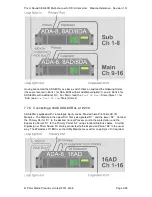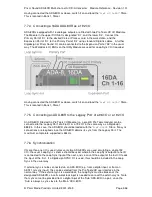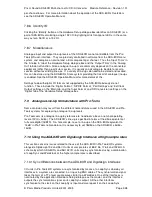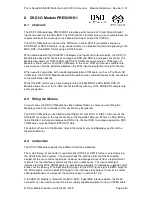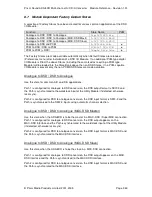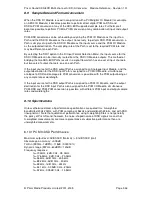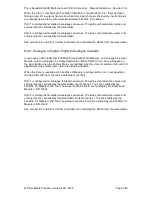
Prism Sound ADA-8XR Multi-channel A/D D/A Converter Module Reference - Revision 1.01
© Prism Media Products Limited, 2001-2005
Page 3.45
For correct operation, all the inputs to each DSD I/O Module must be synchronous - that is,
they must themselves share the same Sync Source.
In the SDIF-3 case, only one of the eight DSD input channels can be used as the Sync
Source at any given time. The user may choose which channel using the DI Sync Input menu
(Preferences). For each DSD I/O Module, the sync may be fixed at any one of the eight
channels, or the selection may be set to automatic, whereby the ADA-8XR rotates through the
eight input channels in turn until it finds one that is locked.
Automatic input selection is the default and will suffice for most purposes - the user can
connect a DSD input to any of the channels without having to worry about which one will be
used for synchronization. There are, however, certain situations where automatic channel
selection is not appropriate and in these cases the sync channel must be selected explicitly
from the DI Sync Input menu.
One such case arises because disconnecting a Path's Sync Source causes the Path to mute
momentarily while a new Sync Source is found. If, for any reason, the user needs to
disconnect a DSD input without disrupting the other channels of the Path (for instance, if a
Path's eight channels are being shared by more than one session), automatic selection
should not be used, and a reliably-present stream should be nominated explicitly.
Automatic selection should also be avoided when one or more of the input channels to a DSD
I/O Module is itself synchronized from the Path, and the Path is synchronized to 'DI'. This
would occur, for example, when some of the outputs of a digital-to-digital Path are fed back
into the inputs of that Path (possibly after passing through some other input-synchronized
equipment). Such loops create problems with automatic stream selection - if a channel is
selected whose sync is derived from the Path it is synchronizing, the Path will not lock
correctly. In situations like this, the user should select a sync channel that is not part of a
dependency loop.
8.8.2 Synchronizing to SDIF-2 (DSD-RAW) Inputs
The DSD I/O Module cannot act as a sync source for the ADA-8XR when the ‘SDIF-2’ option
is selected in the DI I/P Format Selection Menu. This is because SDIF-2 carriers do not
contain a synchronization clock The ADA-8XR Path should instead be synchronized to the
connected equipment using a standard wordclock or AES11 connection, or else the ADA-8XR
should be clock master and the source equipment should be slaved from it.
8.8.3 Synchronizing to the MAC-DSD Interface
When the 'MAC-DSD' option is selected in the DI Input Format Selection Menu the MAC-DSD
input can act as a Sync Source for either Path of the ADA-8XR (provided that a valid MAC-
DSD stream is connected to the Module input). The user may select DI1 or DI2 in the Sync
Source menu to synchronize that Path to the MAC-DSD input of that I/O Module.
8.8.4 DSD I/O Module Synchronization Output
If the ADA-8XR is to be the synchronization source (i.e. clock master) for the DSD equipment
that it is interfaced to, the black BNC plug on the squid cable should be connected to the
equipment clock input (or alternatively it may be possible to synchronize the equipment from
an SDIF-3 or MAC-DSD data feed). This DSD I/O Module clock cable carries a wordclock at
1/64 of the DSD output rate, and is functionally independent of the assignment of the
wordclock output on the Utility Module.





